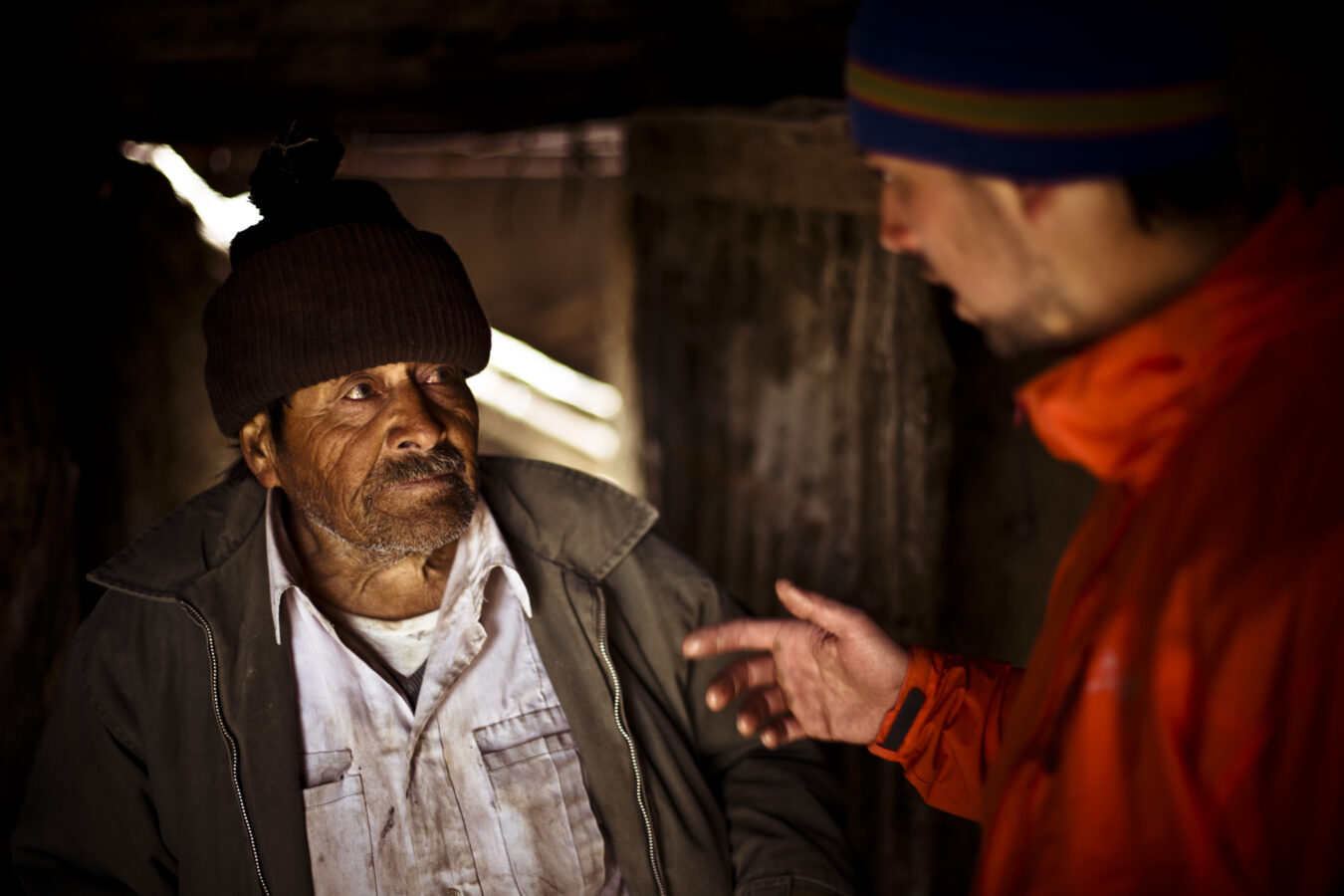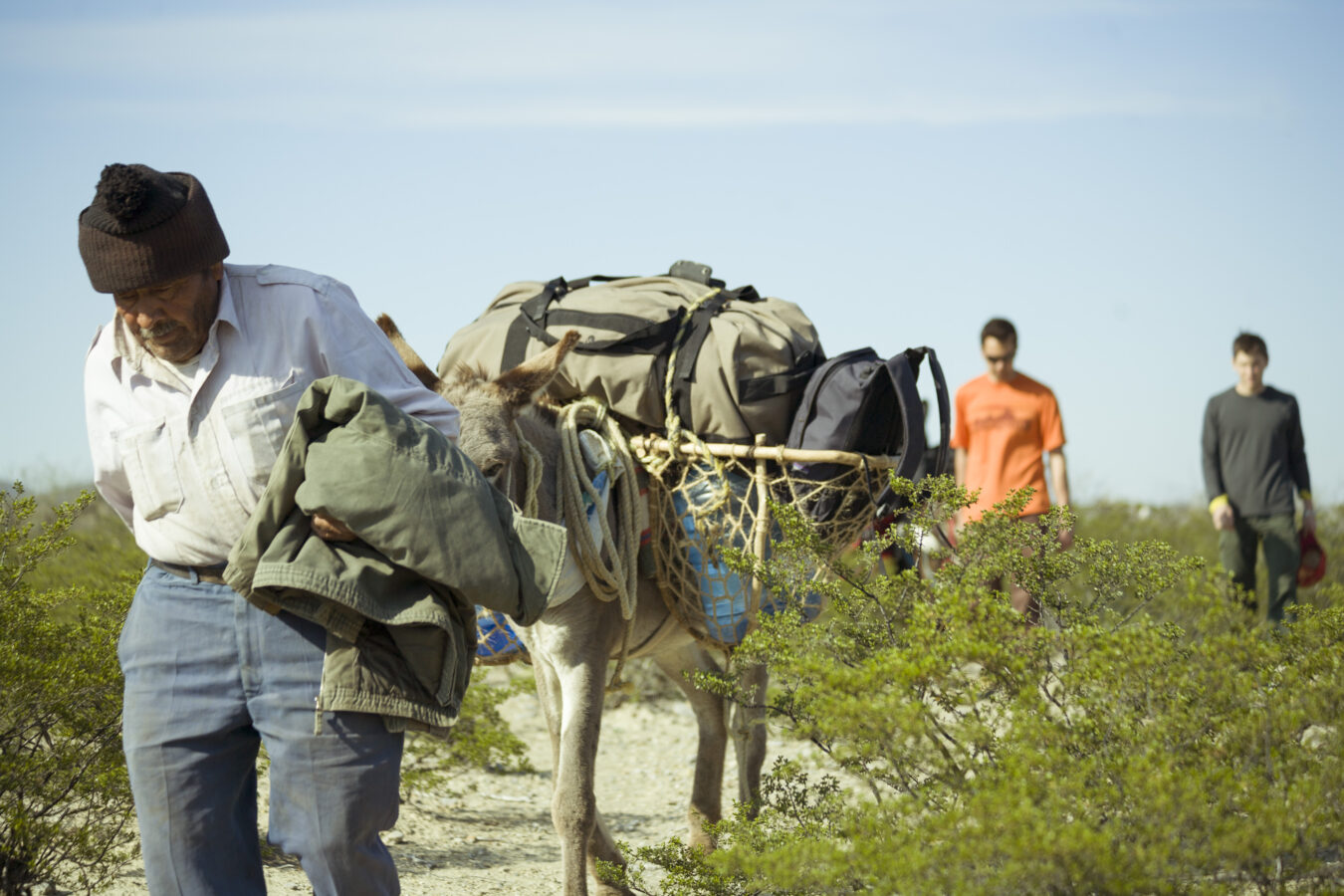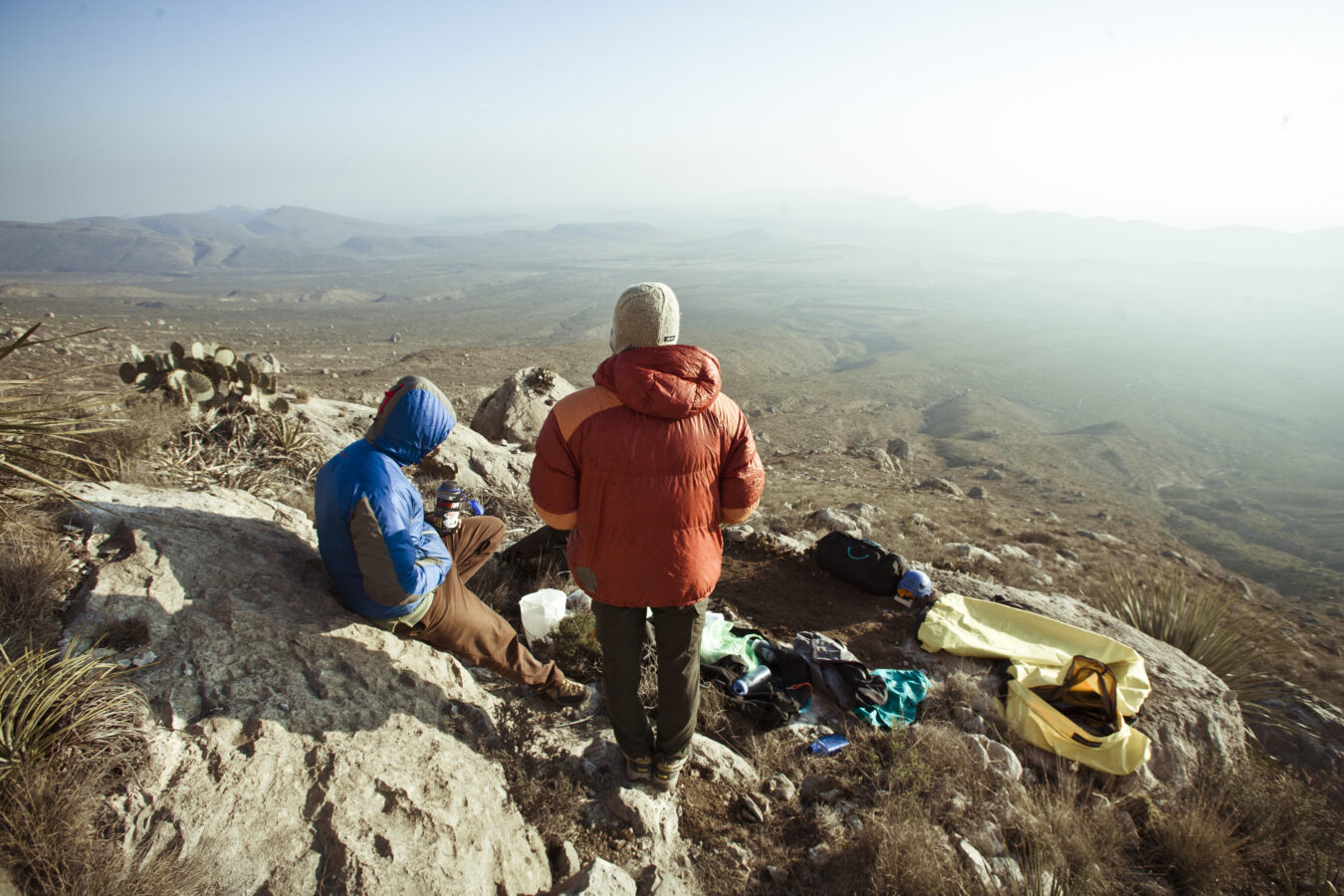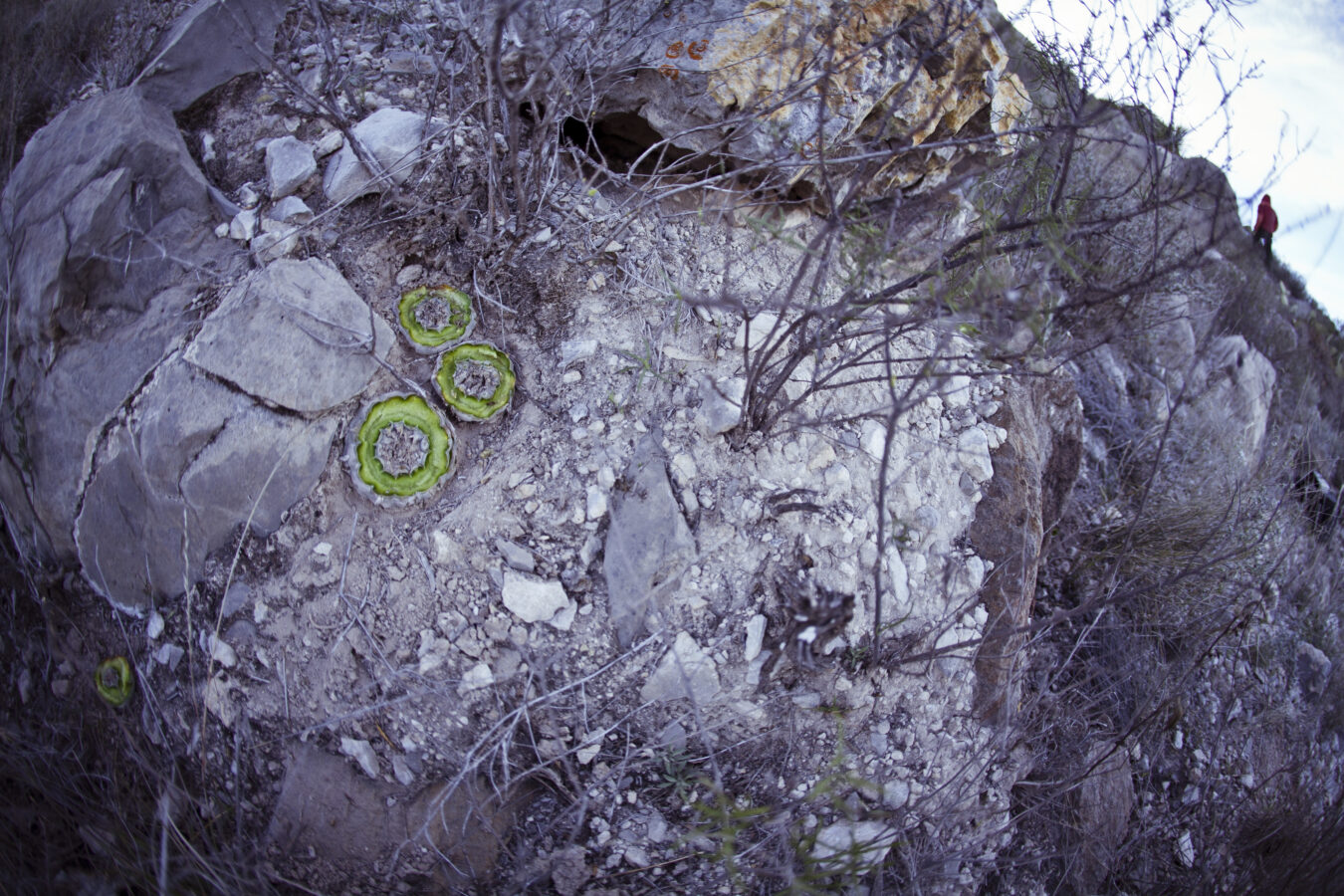Author note: The below story is a piece I wrote years ago for Rock and Ice magazine, about a trip to Los Remotos, Mexico, with my friends Dan Mirsky and Boone Speed, to try to climb Jeff Jackson’s route El Gavilan. We failed spectacularly, due to bad weather, bad rock, and old sketchy bolts. I was super inspired to see that Jacob Cook and Bronwyn Hodgins updated El Gavilan with new bolts, added their own route to this 900-foot cliff, and dialed in a new approach from the top that made access much easier. Their efforts are documented in this new film from Savannah Cummins, which I wanted to share. I’m also including my story, to which I gave a few tweaks and edits in order to update the ending.
The whole whacked adventure began like this:
“They say there’s a cave with treasure. No one who’s entered, however, has come out. To get there, you have to pass through the Naguales, which are half-horse, half human.”
Naguales?
“Yep. On our first night there, the hillside was covered with lights. The lanterns moved closer so we put our fire out and hid. Fog rolled in, and we slept. That morning, we walked down the hillside. There were wild horses everywhere.”
Naguales! Are they dangerous?
“At the base of the hillside we passed an engraved rock. It read: ‘¡A todos los gringos que pasan aqui, matan los, ver!’”
What does that mean?
“‘To all those gringos that pass here, they kill them, see!’ There are also scorpions, rattlesnakes, centipedes and las momias de Monterrey.”
Mummies?
“Oh, yeah.”
What else?
“Peyote grows everywhere, but you can’t see it until the time is right.”
How do you know when the time is right?
“It’s right when you see it. They also say there is a light in the sky called the Visitor.”
In Mexico?
“Yes. Outside of a puebla called Los Remotos. I made half a dozen trips here, to climb El Gavilan. The Hawk. Nine pitches, 5.13b. No pitch is easier than 5.12. … Leo Houlding went up to try it, but he never made it past the peyote.”
It hasn’t had a second ascent?
“Nope.”
Jeff Jackson—editor, friend and fountainhead of bizarre narratives—finished telling the El Gavilan story. I’d heard the tale before and my questions were merely softballs I pitched to “Jefe” to recreate the ebb and flow of this strange fable I’d come to enjoy.
I didn’t believe a word of it, but still liked the whimsical tale. The second ascent of a difficult free climb, though, was the most attractive thing to my friend Dan Mirsky and me.
“Jefe, we want to do your route,” Dan said.
“Really? Well, let’s go!”
(Having a boss who thinks that going to Mexico is always a good idea is cool.)
“I hope Luciano is still alive,” Jeff said.
“Who’s Luciano?” I asked.
“The burro man. You’ll need to take donkeys up the hillside. Ten years ago, when I did the route, Luciano was 60. His hands were like lizard skin, and he loves oranges.”
“Do you think Luciano is still alive?” I asked.
“It’s not likely,” Jeff said. “No.”
Though absurd, the trip felt exciting. Clipping bolts at Rifle and running through the grades is fun, but only so fulfilling. Climbers, even sport climbers like us, are naturally subject to the magnetic laws of adventure, the weird compulsion to do something crazy. And after projecting the same steep faces for two years, we felt a pull, which became impossible to ignore, toward this Mexican lodestone.
Fate, destiny, luck, magic. These are the names we give the natural forces that can’t be reduced by science.
We know that gravity is a function of mass, and light is the fastest thing around, but no one can explain why the worst things sometimes happen to the best people without sounding at least a little bit artless.
Because these forces aren’t easily understood, they’ve been facetiously dismantled and branded utter nonsense. Humanity has spent the entirety of its efforts trying to control and shelter its constituents from the uncontrollable and unpredictable. Modern Western society, so far, is its greatest endeavor toward this end.
Before even reaching Mexico, I was already viewing this trip to El Gavilan as a cure to the overly determined and banal order of life’s logic.
If I train, I will send. If I use my credit card, I can buy what I want.
El Gavilan brewed a kind of wonder not found in the rote machinations of sport-climbing life. What if there really were Naguales? What if they killed us? Why couldn’t magic and fate govern Mexico’s most remote corner?
In February 2007, Homero, the happy Mexican cowboy, met Jeff and me at the airport and brought us to his famous campground in El Potrero Chico. We met up with other friends, including Lynn Hill, her rambunctious four-year-old son Owen (dubbed “El Diablito” by locals), and Boone Speed, a climber and photographer.

Dan, with whom I’d trained all winter and also experienced a series of highs and lows in our friendship, had left me a distraught message that began, “Andrew, I don’t know how to say this …” Dan, bouldering in Hueco Tanks, had torn his meniscus. “I don’t know if I can climb, but I’m coming anyway.”
Dan and I had first met three years prior in Colorado, but we actually grew up in nearby New York towns; we were also born just two days apart in August. We’re both Leos—opinionated, swaggering, center-of-attention-seekers—though Dan is more classically a lion than I am.
Over the past winter, I’d confronted Dan, telling him that he could be a high-maintenance friend (he is). He said that that was because I push people away (I do). We let it sit, and continued pumping campus boards to the beats of Wu Tang.
When Dan arrived in El Potrero, he seemed able to limp around on his bad knee well enough. His climbing ability had been compromised from the torn meniscus, but it was really his greatest asset, his confidence, that had sustained a more devastating blow.
“Do you still want to do El Gavilan?” I asked.
“I think so,” Dan said. “I guess so.”
The longer we stayed, the harder it was to leave. El Potrero is such a dope hang. There’s nothing better than sipping an ice-cold Caguama (quart of beer) after a hot day on the big wall.
People started treating us differently when they heard that we wanted to do El Gavilan. They talked to us as if we were something special (we’re not), and did too much to help us on our way. All this, just because we wanted to climb a route no one ever does.
Still, I couldn’t shake the feeling—an intuition, which I’d normally dismiss anywhere else—that we were going to let everyone down.
Homero dropped Dan, Boone and me off in Los Remotos, a windswept plain of fruitless, forsaken dirt.
Jeff came along to point out the mile-long wall, La Popa, and its one route, El Gavilan, all the way up the fabled hillside.
The wall looked awesome: tall, steep and water-streaked. The obvious gold and black stone of center-left, Jeff said, was the route. He bid us goodbye and good luck and left us to the whims of Los Remotos.
Dust settled and the environment turned hauntingly silent. Through the hot haze, a figure slumped over a donkey’s back rode our way.
The man dismounted and limped badly. His leg was bent at the shin bone, forming a sick angle. To prevent the lame appendage from dragging, he had rigged a string so that one end was tied around his knee and the other end was fixed to his belt. He introduced himself: Edgardo.
We asked Edgardo if Luciano, the burro man, was still around. He said yes. We said we wanted to hire burros to transport our water and supplies. He said Luciano would be here soon.
I felt a pang of déjà vu. Once, I had dreamed of a man with a broken leg held together by a string. Totally bizarre, right? I considered that Edgardo might be a fateful omen that said, “Turn around! Go back! Be gone!”
It turned silent. The wind waved its hands over our necks and the sun began to flatten its light, and eventually, Luciano arrived with his burros.

Luciano was a squat, old creature of the desert. From his cracked exterior shone two eyes, bright and blue from cataracts, that watered as he studied me. He embraced my arms with reptilian hands.
Luciano insisted on showing us his home where he had lived for over half a century. By home he meant a hole in the ground: a space dug into a mound beside a dried-up river. A thatch of straw and wood, now rotten, formed an ersatz roof. There were a fire pit, an exhausted mattress, and a tiny platform cut into the wall that held a painting of Jesus. His was an impoverished existence beyond fathom.
Soon, Luciano strapped wicker baskets to two burros, and we loaded them with our gear and water. To move the stubborn beasts, Luciano belched a guttural Hyaaah! It was a noise somewhere between human and animal. One burro’s neck was cut to shit—the repeated lashing and choking had gouged deep red canyons into its flesh.

Luciano left at dusk, and I gave him a spare headlamp to help the old ranchero find his way down. We watched the LED drift slowly to the plains below at the unfamiliar speed of life itself here in Los Remotos.
“What’s he going to do when that thing runs out of batteries?” Boone asked.
“Did you guys see any peyote?” Dan asked.
“Nope. No Naguales either,” I said.
“Well, maybe they’re coming tonight,” Dan said.

Watching the stars, we drank every last drop of alcohol we’d brought for the entire trip.
“Shit,” I said, finishing the añejo. “I thought that would last longer.”
“What’s that?” Dan said. Over distant mountains, a large light-orb vibrated in the sky.
“That’s the Visitor!” I said.
The Visitor was whitish-blue, bright and hovering. Suddenly, it jumped across the zenith, stayed there for a bit, vibrating dementedly, and zipped back to its original spot. We’d never seen anything like this. The fact that we were witnessing something strange for real made us crazy with fear.
Then the Visitor faded and vanished.
“That was different,” Boone said finally.
The next morning, we hiked (Dan hobbled) to the base. That we might just onsight the whole climb was a fun idea to which neither Dan nor I were brash enough to give words. Our plan was for me, the worse free climber, to take the first pitch (5.12a), and Dan to lead the next two (5.12d, 5.13b), and for me to take the fourth and fifth (5.12d, 5.12a). Depending on our progress, we’d either finish the remaining four pitches, or fix lines and come back the next day.
We pounded fists, and I started up with the nervous pressure that a fall would fuck the pace for the entire climb. An onsight, however, could be just the adrenaline shot we needed.
The climb, however, had a different plan for me. The rock was dirty (to be expected), but what freaked me out was the loose slab with bolts in it that I was on. It was terrifying. I grabbed one crimp that felt as hollow and thin as papier-mâché, and surrendered. “Take.”
The otherwise normal act of resting on the rope was the butterfly flutter that put our doomed destiny in motion. On the next pitch, Dan took 10 falls while ripping choss. You might think he was trying to tunnel into the wall rather than climb it.
“You going up or in?” I said, trying to lighten the mood.
The crux went better. Dan nearly onsighted the 5.13b stemming corner except he fell on two 5.10 sections when more holds ripped. Mentally, the situation was poison.
We dogged up to the top of the fifth pitch, and came down. It was late and cold.
We fixed a line to our high-point anchor: completely rusted quarter-inch chain.
Camp was sober that night. The tequila was gone and the climb was underwhelming.
“It got cold up there,” I said.
“Yeah, it was cold,” Dan said.
Then the Visitor returned. It repeated its performance of last night, zipping around the sky, vibrating nervously, shining brightly.
“If it just disappears again, I’m going to flip out,” Boone said.
Right as he said that, the Visitor faded and vanished. As promised, Boone flipped out. We laughed. The wind changed; a warm breeze blew from the south.
“You feel that?” Boone asked. “The wind. It’ll be warmer tomorrow. Maybe the rest of the route will go better.”
It was the first good omen we’d encountered, and as faint as the subtle shift may have been, we latched onto it with all our remaining hope.
Warm and sunny skies had us jugging up 500 feet of free-hanging rope early next morning. I swear to God that as soon as we reached our high point and were ready to climb, the capricious weather began pummeling us with hard, cold gusts from the north.
“What the hell?” Dan shouted through the chaos. It felt like it was 30 degrees. We shivered, unwilling to admit defeat, but unable to climb the difficult moves in these conditions.
We considered just getting to the top of the wall at A0 … but we had come to free climb, not hangdog. It really seemed like everything had been working against us: the weather, Dan’s knee, the bad rock, the rusted bolts and, yes, even destiny. We arrived in hell-and-gone Mexico fit enough to repeat the strangest big-wall free climb in the world, but there is no training for going against destiny’s current.
For the first time in this story, instead of pushing forward despite intuition, we chose to go back.
Dan said, “I’m glad we came here. You’re the only person I would’ve wanted to do this with,” and that’s when it was officially over. The comment sounds cheesy now, but it was appropriate for the moment, even if I didn’t feel comfortable letting it penetrate. Unlike usual, I did not push away from my friend, but slowly rapped down in warming silence.
Boone was at the bottom. It must’ve looked like we needed consolation because he said, “Seriously, that was a really good effort.” We chose to believe him.
“What now?” I said.
We still had 30 hours until Luciano would come with the burros. Boone pointed at the ground and said, “Look.”
“What?”
“There,” he said. I looked closer, and closer still, and sure enough in the gray earth was a gray cactus lying flat against the ground. Peyote, the one thing that this barren land could produce, had chosen to reveal itself to us. I looked up, and saw it everywhere.

Jefe had told us to eat 12 buttons but I could only manage to eat 6 without feeling like I was going to vomit. Peyote tastes like gasoline and tinfoil, and the nausea persisted for a few hours as we sat on this bleak hillside. Eventually, though, the illusion of the self dissolved into the warm fuzziness of a heightened experience. I turned into a mole in my head and burrowed into a tunnel that was my sleeping bag.
We found a spot on the hillside that sheltered us from the wind, and sat there to watch time pass. Los Remotos looked beautiful on that final night. The waning sun fell perfectly across the lonely landscape, and the sheer openness of the space read like a book of life’s answers.
Fate, destiny, magic and luck differ from the laws most of us know and obey. But ultimately, they have the real power. These forces had reduced us, and in that crushing space, it became clear to me that choice is not about control. Choice is about response.
The Visitor appeared once again. This time we said nothing; just watched the show. It could come every night and no one would ever know what it was. This was a world before cell phones, before a time when you could just Google your way out of every curious itch. We live in a world where easy answers are now everywhere and readily available. But something is lost with access to this glut of information. Sitting with uncertainty, with questions, with the beauty of a mystery is a rare experience that transforms you from a person filled with the hubris of believing you know what’s right to one who can just admire the fact that the universe is far weirder than anyone can comprehend.
In El Potrero, we’d returned to a place where anything we wanted was at our fingertips. A day after leaving Los Remotos, we were on a budget airline that, for $50, shot us to the beaches of Zihuatenejo. The instantaneousness of our transformation seemed at odds with all the lessons of Los Remotos.
No matter. Over the next week, we surfed, ate raw fish cured with limejuice and drank beer all day. It was a break from climbing and its inherent pressure to succeed. Dan and I rested in silence on the beach, watching waves, in their most warm and pleasant form, roll in from the cold, distant violenceof Antarctica. We didn’t speak. The ocean was loud and did all the talking needed. Life was totally comfortable.




0 Comments